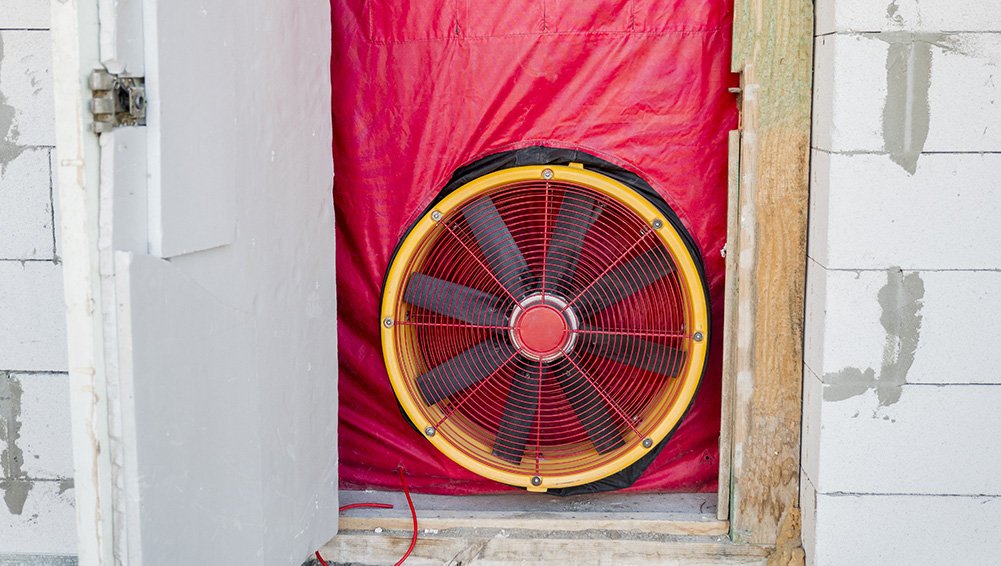What Is Air Pressure Testing?

Overview of Air Pressure Testing
So – what is air pressure testing? Air pressure testing calculates the air tightness of a building, known as its ‘air permeability’ or ‘leakage’ rate. Air leakage is air that escapes the building via uncontrolled means. Leakage can occur through gaps, holes or cracks in the fabric of the building. Excessive air leakage can affect the building’s energy efficiency, making the building less energy efficient and more expensive to run.
Why Do I Need Air Pressure Testing?
We've covered 'What is Air Pressure Testing?' but why do you need it?
Part L1A and L2A (England & Wales), Section 6 (Scotland) or Part F1 (Northern Ireland) of The Building Regulations require Air Pressure Testing. Air Pressure Testing has been mandatory for new build residential and commercial properties in England, Wales and Northern Ireland since 2006, and in Scotland since 2010.
This is to make sure the building meets or exceeds the air permeability rating specified in your design stage SAP or SBEM Calculations. Maintaining a high level of air tightness within a building contributes to high quality energy efficiency.
Failing to maintain air tightness can result in up to 40% heat loss. If you’re investing in energy efficiency measures, such as a new boiler or extra insulation, your efforts could be in vain if the building’s air tightness isn’t adequate.
In some cases, extended commercial properties require air pressure testing. For instance, commercial extensions that have a total useful floor area 25% greater than the existing building or larger than 100m2 will need testing. Although not legally required for residential extensions or conversions, many people have the test performed for peace of mind.
How Is It Done?
You or your architects should provide us with the complete drawings (floor plans, sections, elevations and site plan). Once we have all the information, we’ll use the air tightness target found in your design stage SAP or SBEM calculations as a benchmark. Our technicians calculate air tightness via the following process:
- We'll install a large fan temporarily, usually in a doorway.
- Next, we will temporarily seal openings to the property and switch the fan on.
- Air pressure is gradually increased and decreased, recording the pressure differential at each step.
- The total air flow required to achieve a pressure differential of 50 Pa is calculated and divided by the total building envelope area. This provides the leakage rate in m³/h.m² @ 50 Pa.
- This calculation will show the building's air tightness or air permeability.
- Contractors can continue work within the property but all windows and doors have to remain closed for the duration of the test.
When Should It Be Carried Out?
You should carry out air pressure testing towards the end of your project. UKBC will provide you with a site readiness checklist to help you determine when your building is ready.
How Long Does It Take?
Duration of the test will depend on the size of the property and the level of preparation undertaken before testing. Generally, the duration of the actual test should take no longer than two hours.
What Happens If My Building Fails?
There are a number of different factors that increase air permeability. For example, the most common are:
- Insufficient sealing around windows and doors.
- Spaces behind fitted units such as windows or bathrooms.
- Cracks around sockets and other electrical inputs.
- Gaps where the external wall meets a floor.
- Space around any pipework leading into the building.
At UKBC, we want your building to pass. To make sure, we provide consultation and on-site training for your contractor about reducing leakage rates in problem areas.
However, if your building does fail, we offer a number of services to ensure that the process is ultimately a success. Our technician will give you full feedback and suggestions to help you make changes which will ensure a pass during the second test.
Smoke Testing
During a smoke test, our technicians will fill the building with smoke and pressurise the space. This will provide a visible indication of the problem areas, as the smoke will flow through the openings. In less extreme situations, we can use devices known as ‘smoke pencils’ to complete the task.
Depressurisation
Depressurisation is conducted by pressurising the whole building, forcing air out through any gaps or cracks. When our technicians reduce the pressure, there will be draughts as the air rushes back into the room, indicating where the air is escaping.
Thermography
Thermography uses infrared cameras to detect where the hottest and coldest spots are in the house.
Share
